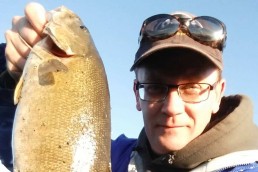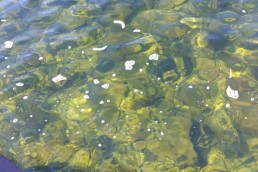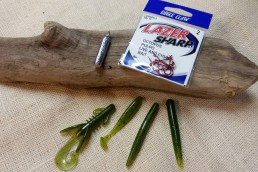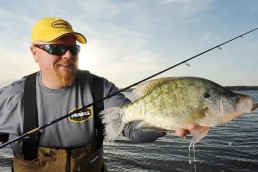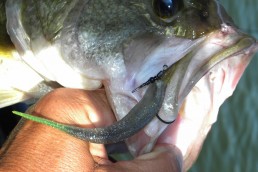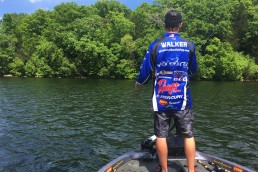Bomb-shotting Smallies Long-range drop-shotting for Door County smallmouths
SHARE THIS POST
My July article has traditionally been my tribute to one of the greatest fisheries in the country right here in our back “door”—Door County smallmouths. With the busiest vacation season happening up here now, and if you find yourself a visitor, take advantage of some of the best smallmouth bass fishing in the world.
Not that I need to sell most of you on the bass fishing in Door County, but I would like to mention that the Bass Anglers Sportsman Society (B.A.S.S.) rankings for the top 100 “Best Bass Lakes” in the country are out again. Two years ago, Sturgeon Bay was ranked number 1. This year, it got bumped to number 2. That is still an incredible ranking knowing all the fabulous bass destinations that are out there.
The great thing for shore fishermen is that these fish are available from piers, breakwalls and various locations all along Door County. The action starts as you enter the city of Sturgeon Bay and includes every town up the coast to Northport.
One of the challenges with shore fishing the ports here in summer is getting out away from the shore and finding a little deeper water. Many anglers go to very heavy jigs tipped with 3- or 4-inch twister tails. In order to get far offshore, many of these jigs are in the 3/4- to 1-ounce weights. While this does work under certain circumstances, the gin-clear waters here don’t always lend themselves to such a power presentation. A 1-ounce football jig head is big, and even if you can get a smallie to pick it up, they will generally eject it quickly because it just doesn’t feel right to them.
Door County has become a finesse fisherman’s dream, with light lines and subtle lures. So how do you get off the shore with some weight, but still maintain a finesse presentation?
You can do this by using a presentation I call “bomb-shotting.”
Bomb-shotting is a variation of drop-shotting, but with a heavy twist. In traditional drop-shotting, I like to use the lightest drop-shot weight I can get away with. In bomb-shotting though, I am using the heaviest weight I can get away with—I want to “bomb” the cast as far as I can.
Let’s start with tackle. Use what you have, but if you can get a 7- to 8-foot, medium-light-action spinning rod, that is perfect. The longer rod will allow for longer casts and give you a better long-range hook-set. I have used medium-light-action steelhead rods and they work well. Lately, I have been using a 7 1/2-foot, medium-extra-fast-action St. Croix that has the guts to cast a 3/4-ounce weight, yet have enough tip action to work a finesse bait and have a delicate feel.
Are you enjoying this post?
You can be among the first to get the latest info on where to go, what to use and how to use it!
For reels, any quality 2500 to 3000 reel loaded with 6-pound-test fluorocarbon line will work. The heaviest, clear line I would recommend would be 8-pound-test, but I would stick to 6-pound-test if you feel more comfortable with it.
For hooks, I like a super-sharp, size 2 drop-shot-type hook or an octopus bend. Normally, I don’t feel like I need the expensive hooks, but in this case I spend the cash. For this long-distance drop-shotting, I want the hooks sticky and sharp; I would like the fish to nearly hook itself. Also, with possibly a 200-foot cast between you and the bass, you need any advantage you can get to stick the hook from a long range.
The rigging is traditional drop-shot rigging. I use a Palomar, leaving a 2-foot tail on the end for the weight. If you are using a longer steelhead rod you may be able to sling a longer leader, at 2 to 3 feet. That’s a little longer than for most drop-shotting, and you’ll need to remember the angle you are at on a long-range bomb cast.
This is where it gets a little different: Instead of a finesse weight, drop-shot amounts at 3/4- to 1-ounce weights are needed for bomb-shotting. Any shape will work, but I have found that the long pencil weights are less susceptible to snagging on the rocky Door County bottoms.
On the hook, finesse plastics are the answer, and keep the sizes to about 3 inches. The 3-inch wacky worms, goby imitations, small fluke baits or small creature baits are the ticket. For colors, it’s hard to beat watermelon inside Door. That should be your number one choice and then go from there. Smoke with red flake can work well too, as can purple or June bug colors at times. The fluke baits can work well in traditional minnow colors. The Lunker City Fin-S Fish or Zoom Tiny Fluke in Arkansas Shiner are two good options.
So here’s how it works: Launch the rig offshore as far as you can. You will be amazed at how far you can launch your 3/4- ounce drop-shot weight on 6-pound-test fluorocarbon. Let the rig get to the bottom and tighten up the line. Shake the tip lightly and then stop and hold tension on the line. I will repeat that one more time and wait for about five seconds for a hit. If nothing happens, lift the rod tip and move the rig 5 to 6 feet. Repeat the light shaking with the rod tip. Some hits will feel like something slamming the bait; most will feel like the line is suddenly getting heavy. In either case, set the hook hard. One cast will take several minutes to complete, but you are covering a large piece of water very slowly. If you prefer live bait, a jumbo leech will stay on the hook during this powerful cast, the nightcrawlers or minnows, not so much.
Bomb-shotting is a long-range application for shore fishing with a drop-shot rig. Rigged with some finesse plastics, it will get you into some of the biggest smallmouth bass in the country. Get up to Door County this summer and get into some of these giant bronzebacks. MWO
MWO
SHARE THIS POST
Did you enjoy this post?
You can be among the first to get the latest info on where to go, what to use and how to use it!
Marc Wisniewski
Marc Wisniewski is an avid Wisconsin angler specializing in Lake Michigan shore and inshore fishing. He also chases bass, pike, and muskies anywhere he can. He has built custom rods for 35 years and makes lures from wood, lead and soft plastics. Wisniewski has been writing fishing articles for more than 30 years.
